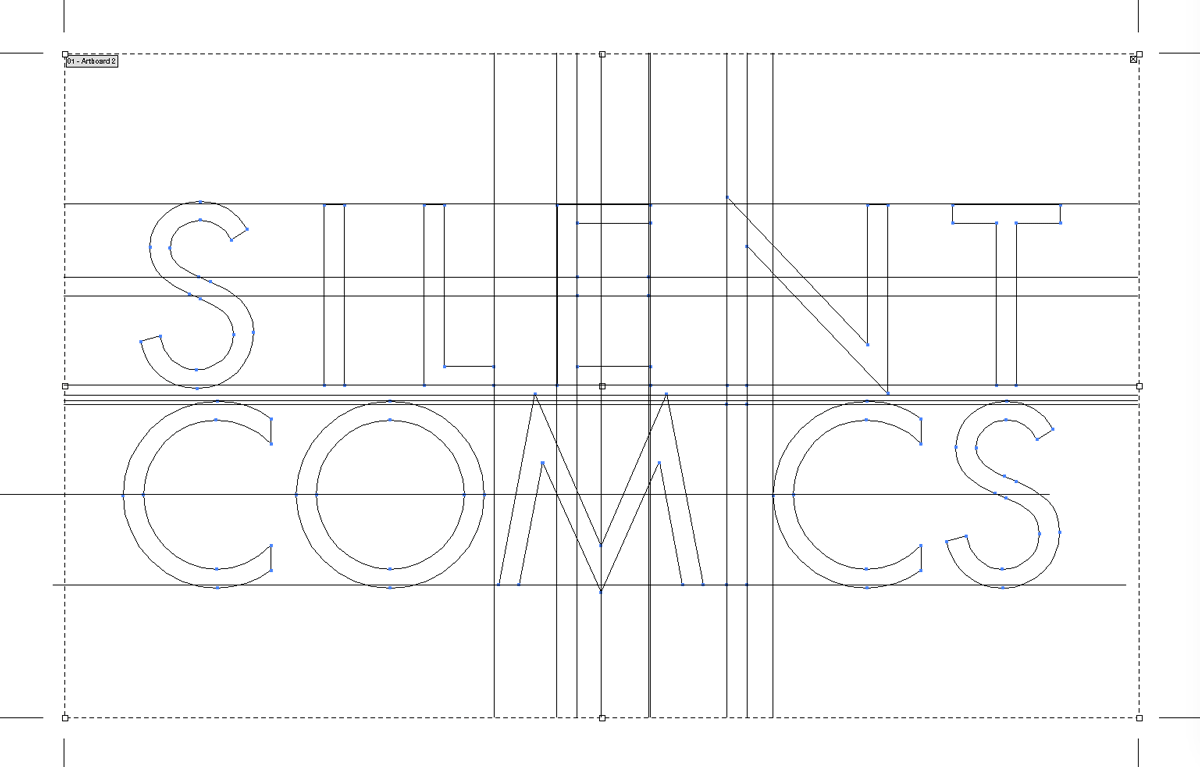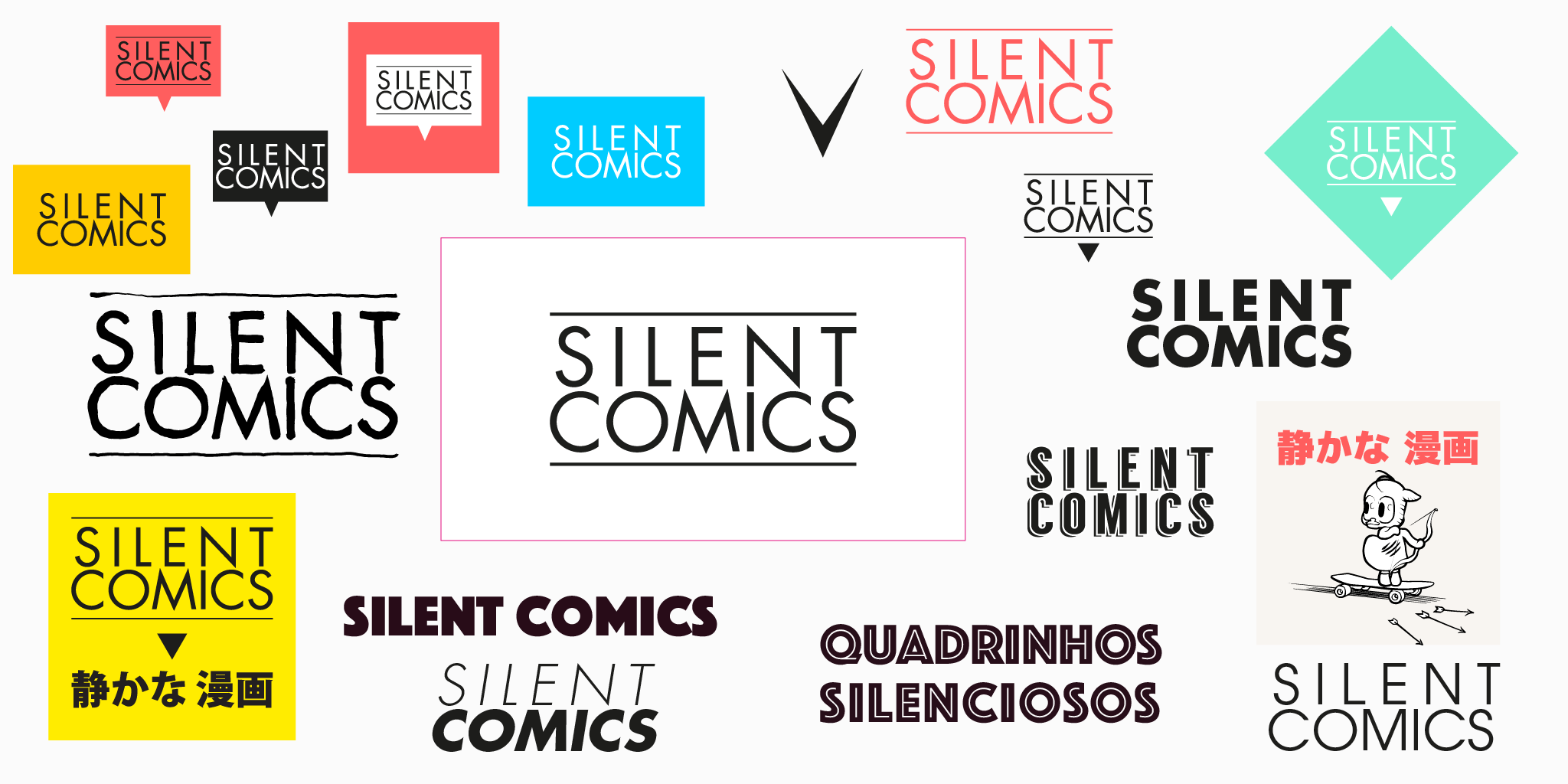Wordmark
A wordmark
Writing a name is one of the most basic forms of branding. Whereas a logo is a graphic mark, an emblem or a symbol, which can include letters and various typefaces, a wordmark is a typographic treatment of a name. In short, a wordmark is a logo but a logo is not necessarily a wordmark. It makes sense that an image-only project like SILENT COMICS would get its own text-only type of logo.
Futura
For SILENT COMICS I was looking for a typeface evocative of the silent films era but still looking current. There are plenty of inspiring letter types from that time, in particular posters and title cards hand-drawn letters. But the simplicity and timeless elegance of Futura are unmatched. A geometric typeface designed by Paul Renner and released in 1927, Futura has arguably been overused. You can spot it everywhere: in movies, signage and corporate literature. It also served as the basis for countless logotypes. Rather than a problem, I see its success as a reminder that modernity is built from the past. Modernity can and in fact should go hand in hand with long-lasting quality. The SILENT COMICS logo uses Futura Book. Aside from its name, it has little visual connection with comics. That is good, I like the quiet, ordered feel of restraint it has now, which contrasts with the subject matter.
Simplicity
Besides kerning, the only addition to the letters is two horizontal lines, above and below the name. They stand for the (comics) frame, giving the ensemble a bit more stability. Notice how it is open on the sides. At some point, I added a triangle underneath to suggest a comic book balloon. Then decided against it: too decorative. Plus, there won’t be any balloons in this project. I like what Raymond Poïvet1 had to say about comics: (in French) “Bande dessinée” means “drawn strip”.
And that’s all there is to it.

SVG
Base642 code:
<a href=“https://silent-comics.com” class=“logo”><object type=“image/svg+xml” data=“data:image/svg+xml;base64,PHN2ZyB4bWxucz0iaHR0cDovL3d3dy53My5vcmcvMjAwMC9zdmciIHZpZXdCb3g9IjAgMCAxOTggOTkiPjxzdHlsZT4uc3R5bGUwe2ZpbGw6ICMwMDA7fTpob3ZlciB7ZmlsbDogI2ZmY2MwMDt9OnZpc2l0ZWQge2ZpbGw6ICNmZmY7fTwvc3R5bGU+IDxwYXRoIGQ9Ik0xNS40IDQ0LjJjLTQuMSAwLTcuMS0zLjItNy42LTcuMWwtNC4xIDEuMmMxLjIgNS45IDUuOCA5LjkgMTEuOSA5LjljNi42IDAgMTItNS4xIDEyLTExLjggYzAtNi4xLTQuMi04LjYtOS4yLTEwLjdsLTIuNS0xLjFjLTIuNi0xLjItNi0yLjctNi02YzAtMy41IDIuOS01LjkgNi4zLTUuOWMzLjIgMCA1LjEgMS41IDYuNiA0LjFsMy40LTIuMmMtMi0zLjctNS42LTUuOS05LjktNS45IGMtNS43IDAtMTAuNyAzLjgtMTAuNyA5LjdjMCA1LjUgMy44IDcuNyA4LjMgOS44bDIuMyAxYzMuNSAxLjYgNyAzLjEgNyA3LjZDMjMuMyA0MS4xIDE5LjUgNDQuMiAxNS40IDQ0LjJ6Ii8+PHJlY3QgeD0iNDIuNSIgeT0iOS40IiB3aWR0aD0iNC4zIiBoZWlnaHQ9IjM4LjIiLz48cG9seWdvbiBwb2ludHM9IjYzLjYsOS40IDYzLjYsNDcuNSA3OC4zLDQ3LjUgNzguMyw0My42IDY3LjgsNDMuNiA2Ny44LDkuNCIvPjxwb2x5Z29uIHBvaW50cz0iMTExLjQsMTMuMyAxMTEuNCw5LjQgOTEuNiw5LjQgOTEuNiw0Ny41IDExMS40LDQ3LjUgMTExLjQsNDMuNiA5NS45LDQzLjYgOTUuOSwyOC42IDExMSwyOC42IDExMSwyNC43IDk1LjksMjQuNyA5NS45LDEzLjMiLz48cG9seWdvbiBwb2ludHM9IjE1Ny4zLDM4LjkgMTI3LjUsNy44IDEyNy41LDQ3LjUgMTMxLjgsNDcuNSAxMzEuOCwxOC4xIDE2MS41LDQ5LjIgMTYxLjUsOS40IDE1Ny4zLDkuNCIvPjxwb2x5Z29uIHBvaW50cz0iMTc1LjIsMTMuMyAxODQuNCwxMy4zIDE4NC40LDQ3LjUgMTg4LjcsNDcuNSAxODguNywxMy4zIDE5OCwxMy4zIDE5OCw5LjQgMTc1LjIsOS40Ii8+PHBhdGggZD0iTTE5LjkgOTAuM2M0IDAgOC4xLTEuNCAxMS40LTMuN3YtNS4zYy0zIDMtNy4yIDUuMS0xMS41IDUuMWMtOC41IDAtMTUuNS03LjQtMTUuNS0xNS44IGMwLTguNCA2LjktMTUuOCAxNS40LTE1LjhjNC40IDAgOC42IDEuOSAxMS42IDUuMXYtNS4zYy0zLjQtMi41LTcuMS0zLjctMTEuNC0zLjdDOSA1MC45IDAgNTkuOCAwIDcwLjhDMCA4MS42IDkuMSA5MC4zIDE5LjkgOTAuMyB6Ii8+PHBhdGggZD0iTTM2LjUgNzAuN2MwIDExIDkgMTkuNyAxOS45IDE5LjdjMTAuOSAwIDE5LjktOC43IDE5LjktMTkuN2MwLTEwLjktOS0xOS44LTE5LjktMTkuOCBDNDUuNSA1MC45IDM2LjUgNTkuNyAzNi41IDcwLjd6IE01Ni40IDU0LjhDNjUuMiA1NC44IDcyIDYyIDcyIDcwLjZjMCA4LjYtNyAxNS44LTE1LjYgMTUuOGMtOC43IDAtMTUuNi03LjItMTUuNi0xNS44IEM0MC44IDYyIDQ3LjcgNTQuOCA1Ni40IDU0Ljh6Ii8+PHBvbHlnb24gcG9pbnRzPSI3OS4zLDg5LjcgODMuNiw4OS43IDg4LjUsNjMuOSA4OC42LDYzLjkgMTAwLjksOTEuMiAxMTMuMiw2My45IDExMy4zLDYzLjkgMTE4LjIsODkuNyAxMjIuNSw4OS43IDExNC44LDQ5LjQgMTAwLjksODEuNCA4Nyw0OS40Ii8+PHJlY3QgeD0iMTI3LjUiIHk9IjUxLjUiIHdpZHRoPSI0LjMiIGhlaWdodD0iMzguMSIvPjxwYXRoIGQ9Ik0xNTYuOSA1NC44YzQuNCAwIDguNiAxLjkgMTEuNiA1LjF2LTUuM2MtMy40LTIuNS03LjEtMy43LTExLjQtMy43Yy0xMC45IDAtMTkuOSA5LTE5LjkgMTkuOSBjMCAxMC44IDkuMSAxOS42IDE5LjkgMTkuNmM0IDAgOC4xLTEuNCAxMS40LTMuN3YtNS4zYy0zIDMtNy4yIDUuMS0xMS41IDUuMWMtOC41IDAtMTUuNS03LjQtMTUuNS0xNS44IEMxNDEuNiA2Mi4yIDE0OC40IDU0LjggMTU2LjkgNTQuOHoiLz48cGF0aCBkPSJNMTg1LjcgODYuNGMtNC4xIDAtNy4xLTMuMi03LjYtNy4xbC00LjEgMS4yYzEuMiA1LjkgNS44IDkuOSAxMS45IDkuOWM2LjYgMCAxMi01LjEgMTItMTEuOCBjMC02LjEtNC4yLTguNi05LjItMTAuN2wtMi41LTEuMWMtMi42LTEuMi02LTIuNy02LTZjMC0zLjUgMi45LTUuOSA2LjMtNS45YzMuMiAwIDUuMSAxLjUgNi42IDQuMWwzLjQtMi4yYy0yLTMuNy01LjYtNS45LTkuOS01LjkgYy01LjcgMC0xMC43IDMuOC0xMC43IDkuN2MwIDUuNSAzLjggNy43IDguMyA5LjhsMi4zIDFjMy41IDEuNiA3IDMuMSA3IDcuNkMxOTMuNiA4My4zIDE4OS44IDg2LjQgMTg1LjcgODYuNHoiLz48cmVjdCB5PSI5NyIgd2lkdGg9IjE5OCIgaGVpZ2h0PSIyIi8+PHJlY3QgeT0iMCIgd2lkdGg9IjE5OCIgaGVpZ2h0PSIyIi8+PC9zdmc+”></object></a>| <a href=“http://silent-comics.com” class=“logo”><object type=“image/svg+xml” data=“data:image/svg+xml;base64,PHN2ZyB4bWxucz0iaHR0cDovL3d3dy53My5vcmcvMjAwMC9zdmciIHZpZXdCb3g9IjAgMCAxOTggOTkiPjxzdHlsZT4uc3R5bGUwe2ZpbGw6ICMwMDA7fTpob3ZlciB7ZmlsbDogI2ZmY2MwMDt9OnZpc2l0ZWQge2ZpbGw6ICNmZmY7fTwvc3R5bGU+IDxwYXRoIGQ9Ik0xNS40IDQ0LjJjLTQuMSAwLTcuMS0zLjItNy42LTcuMWwtNC4xIDEuMmMxLjIgNS45IDUuOCA5LjkgMTEuOSA5LjljNi42IDAgMTItNS4xIDEyLTExLjggYzAtNi4xLTQuMi04LjYtOS4yLTEwLjdsLTIuNS0xLjFjLTIuNi0xLjItNi0yLjctNi02YzAtMy41IDIuOS01LjkgNi4zLTUuOWMzLjIgMCA1LjEgMS41IDYuNiA0LjFsMy40LTIuMmMtMi0zLjctNS42LTUuOS05LjktNS45IGMtNS43IDAtMTAuNyAzLjgtMTAuNyA5LjdjMCA1LjUgMy44IDcuNyA4LjMgOS44bDIuMyAxYzMuNSAxLjYgNyAzLjEgNyA3LjZDMjMuMyA0MS4xIDE5LjUgNDQuMiAxNS40IDQ0LjJ6Ii8+PHJlY3QgeD0iNDIuNSIgeT0iOS40IiB3aWR0aD0iNC4zIiBoZWlnaHQ9IjM4LjIiLz48cG9seWdvbiBwb2ludHM9IjYzLjYsOS40IDYzLjYsNDcuNSA3OC4zLDQ3LjUgNzguMyw0My42IDY3LjgsNDMuNiA2Ny44LDkuNCIvPjxwb2x5Z29uIHBvaW50cz0iMTExLjQsMTMuMyAxMTEuNCw5LjQgOTEuNiw5LjQgOTEuNiw0Ny41IDExMS40LDQ3LjUgMTExLjQsNDMuNiA5NS45LDQzLjYgOTUuOSwyOC42IDExMSwyOC42IDExMSwyNC43IDk1LjksMjQuNyA5NS45LDEzLjMiLz48cG9seWdvbiBwb2ludHM9IjE1Ny4zLDM4LjkgMTI3LjUsNy44IDEyNy41LDQ3LjUgMTMxLjgsNDcuNSAxMzEuOCwxOC4xIDE2MS41LDQ5LjIgMTYxLjUsOS40IDE1Ny4zLDkuNCIvPjxwb2x5Z29uIHBvaW50cz0iMTc1LjIsMTMuMyAxODQuNCwxMy4zIDE4NC40LDQ3LjUgMTg4LjcsNDcuNSAxODguNywxMy4zIDE5OCwxMy4zIDE5OCw5LjQgMTc1LjIsOS40Ii8+PHBhdGggZD0iTTE5LjkgOTAuM2M0IDAgOC4xLTEuNCAxMS40LTMuN3YtNS4zYy0zIDMtNy4yIDUuMS0xMS41IDUuMWMtOC41IDAtMTUuNS03LjQtMTUuNS0xNS44IGMwLTguNCA2LjktMTUuOCAxNS40LTE1LjhjNC40IDAgOC42IDEuOSAxMS42IDUuMXYtNS4zYy0zLjQtMi41LTcuMS0zLjctMTEuNC0zLjdDOSA1MC45IDAgNTkuOCAwIDcwLjhDMCA4MS42IDkuMSA5MC4zIDE5LjkgOTAuMyB6Ii8+PHBhdGggZD0iTTM2LjUgNzAuN2MwIDExIDkgMTkuNyAxOS45IDE5LjdjMTAuOSAwIDE5LjktOC43IDE5LjktMTkuN2MwLTEwLjktOS0xOS44LTE5LjktMTkuOCBDNDUuNSA1MC45IDM2LjUgNTkuNyAzNi41IDcwLjd6IE01Ni40IDU0LjhDNjUuMiA1NC44IDcyIDYyIDcyIDcwLjZjMCA4LjYtNyAxNS44LTE1LjYgMTUuOGMtOC43IDAtMTUuNi03LjItMTUuNi0xNS44IEM0MC44IDYyIDQ3LjcgNTQuOCA1Ni40IDU0Ljh6Ii8+PHBvbHlnb24gcG9pbnRzPSI3OS4zLDg5LjcgODMuNiw4OS43IDg4LjUsNjMuOSA4OC42LDYzLjkgMTAwLjksOTEuMiAxMTMuMiw2My45IDExMy4zLDYzLjkgMTE4LjIsODkuNyAxMjIuNSw4OS43IDExNC44LDQ5LjQgMTAwLjksODEuNCA4Nyw0OS40Ii8+PHJlY3QgeD0iMTI3LjUiIHk9IjUxLjUiIHdpZHRoPSI0LjMiIGhlaWdodD0iMzguMSIvPjxwYXRoIGQ9Ik0xNTYuOSA1NC44YzQuNCAwIDguNiAxLjkgMTEuNiA1LjF2LTUuM2MtMy40LTIuNS03LjEtMy43LTExLjQtMy43Yy0xMC45IDAtMTkuOSA5LTE5LjkgMTkuOSBjMCAxMC44IDkuMSAxOS42IDE5LjkgMTkuNmM0IDAgOC4xLTEuNCAxMS40LTMuN3YtNS4zYy0zIDMtNy4yIDUuMS0xMS41IDUuMWMtOC41IDAtMTUuNS03LjQtMTUuNS0xNS44IEMxNDEuNiA2Mi4yIDE0OC40IDU0LjggMTU2LjkgNTQuOHoiLz48cGF0aCBkPSJNMTg1LjcgODYuNGMtNC4xIDAtNy4xLTMuMi03LjYtNy4xbC00LjEgMS4yYzEuMiA1LjkgNS44IDkuOSAxMS45IDkuOWM2LjYgMCAxMi01LjEgMTItMTEuOCBjMC02LjEtNC4yLTguNi05LjItMTAuN2wtMi41LTEuMWMtMi42LTEuMi02LTIuNy02LTZjMC0zLjUgMi45LTUuOSA2LjMtNS45YzMuMiAwIDUuMSAxLjUgNi42IDQuMWwzLjQtMi4yYy0yLTMuNy01LjYtNS45LTkuOS01LjkgYy01LjcgMC0xMC43IDMuOC0xMC43IDkuN2MwIDUuNSAzLjggNy43IDguMyA5LjhsMi4zIDFjMy41IDEuNiA3IDMuMSA3IDcuNkMxOTMuNiA4My4zIDE4OS44IDg2LjQgMTg1LjcgODYuNHoiLz48cmVjdCB5PSI5NyIgd2lkdGg9IjE5OCIgaGVpZ2h0PSIyIi8+PHJlY3QgeT0iMCIgd2lkdGg9IjE5OCIgaGVpZ2h0PSIyIi8+PC9zdmc+”></object></a> |


Graphic design guidelines
(to be continued)
-
“(…) il était admis, tout le monde l’admettait, que, une bande dessinée, c’était d’abord une histoire. Or, je n’ai jamais été d’accord: c’est pas d’abord une histoire, c’est d’abord une bande dessinée, c’est d’abord du dessin.” https://www.youtube.com/watch?v=Vs5RsyrcYKg. See also Philippe Lefèvre-Vakana. “à la recherche d’un chef-d’œuvre de raymond poïvet” (2011, in French) http://neuviemeart.citebd.org/spip.php?article437 ↩
-
Thanks to Mobilefish’s Base64 Encoder to encode a SVG file. See also Using SVG - CSS Tricks ↩